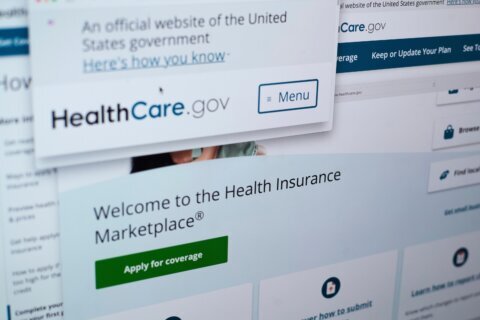This article was republished with permission from WTOP’s news partner InsideNoVa.com. Sign up for InsideNoVa.com’s free email subscription today.
This article was written by WTOP’s news partner InsideNoVa.com and republished with permission. Sign up for InsideNoVa.com’s free email subscription today.
Creating a unified brand and fare policy for the Washington region’s commuter rail systems could help reduce travel times and improve economic development opportunities over the next few decades, according to a new report released Thursday.
The Greater Washington Partnership, with support from leaders of Amtrak, state departments of transportation, and existing commuter rail systems, released its “Capital Region Rail Vision” report Thursday, outlining its plan to seamlessly interconnect Maryland, Virginia, and the District of Colombia.

During a virtual news conference, Joe McAndrew, vice president of the partnership, said one of the key issues for the region is adapting the region’s transportation network to its growing size.
“Our rail system is fragmented, and that fragmentation limits our ability to connect residents to opportunities,” he added.
The fragmentation makes using the various rail services inconvenient and impractical because of how many different connections commuters must make before reaching their destination, McAndrew said. The report stated that to solve this issue, plans should begin to physically connect the Virginia Railway Express (VRE) and Maryland Rail Commuter (MARC) lines and create a unified brand and fare policy to make commuters’ travel experience faster and easier.
“It takes about an hour and a half on a MARC train to get from one center to the other,” McAndrew said. “We’re envisioning on an average the trains will be going under an hour, and faster for express service trends.”
But the report also noted that the group has still not identified a comprehensive way of unifying the commuter lines’ branding and ticketing services, and there are physical barriers to integration as well, such as trying to physically integrate the VRE and MARC train lines because of the differences in procedures and equipment. Several major infrastructure projects also would impede any integration process, including the expansion of Washington Union Station, replacement othe B&P tunnel in Baltimore, and the Long Bridge expansion across the Potomac River, among others.
The report notes that the current network has over 335 miles of total rail lines and more than 54,000 daily riders on average.
In the near future, residents in Alexandria and Arlington County can expect improvements to the Alexandria and Crystal City stations, including Crystal City station expanding its capacity to accommodate more MARC trains – anticipating the new Amazon headquarters being built in Arlington. McAndrew said these improvements would be made by 2023 at the earliest, and by 2030 additional tracks will connect Alexandria and Long Bridge when it’s finished with construction.
Additionally, Amtrak plans to double its service in Northern Virginia by 2030, including daily round trips between Union Station and Richmond to at least eight trips from the current two.
“The limitations are physical today, but they won’t be there forever,” said McAndrew.
With these improvements, Northern Virginia commuters would be able to reach Maryland’s Penn Line stations within a half-hour during peak periods, which is more than a 36% reduction from current transit travel, according to the report.
Building a more integrated rail system, McAndrew said, would improve access to jobs and housing by broadening the housing options available for area workers and enabling employers access to a larger talent pool.
“The Capital Region’s economic and global competitiveness hinges on the ability for residents of all incomes to have easy and reliable access to superb transit,” the report’s executive summary states. “While expansive, the regional rail network represents an untapped resource. The Capital Region Rail Vision charts a course to transform the regional rail network into a globally competitive asset that enables a more inclusive and equitable region.”
The key elements of the group’s vision for commuter rail service are:
- Bidirectional run-through service, meaning a passenger can travel throughout the region without changing trains.
- Expanded service, including all-day service on MARC and VRE lines and increased frequency of trains.
- Seamless rider experience, with one brand and fare policy across the network.
- Superior operational coordination, with one operationally integrated network.
- The Greater Washington Partnership said that over the next few months it will work with its project teams and key stakeholders to develop a more detailed technical roadmap to deliver the vision. This will include approaches to overcoming barriers toward higher levels of service.
Advisory committee members from Northern Virginia who worked on the report included Monica Blackmon, executive director of the Northern Virginia Transportation Authority; Elizabeth Bennett-Parker, vice mayor of Alexandria; Sharon Bulova, former chair of the Fairfax County Board of Supervisors, representing the Virginia Passenger Rail Authority; Kate Mattice of the Northern Virginia Transportation Commission; Clayton Medford of the Northern Virginia Chamber of Commerce; Danny Plaugher of Virginians for High Speed Rail, and Bob Schneider, executive director of the Potomac and Rappahannock Transportation Commission.
The Greater Washington Partnership is an alliance of CEOs in the region, stretching from Richmond to Baltimore.







